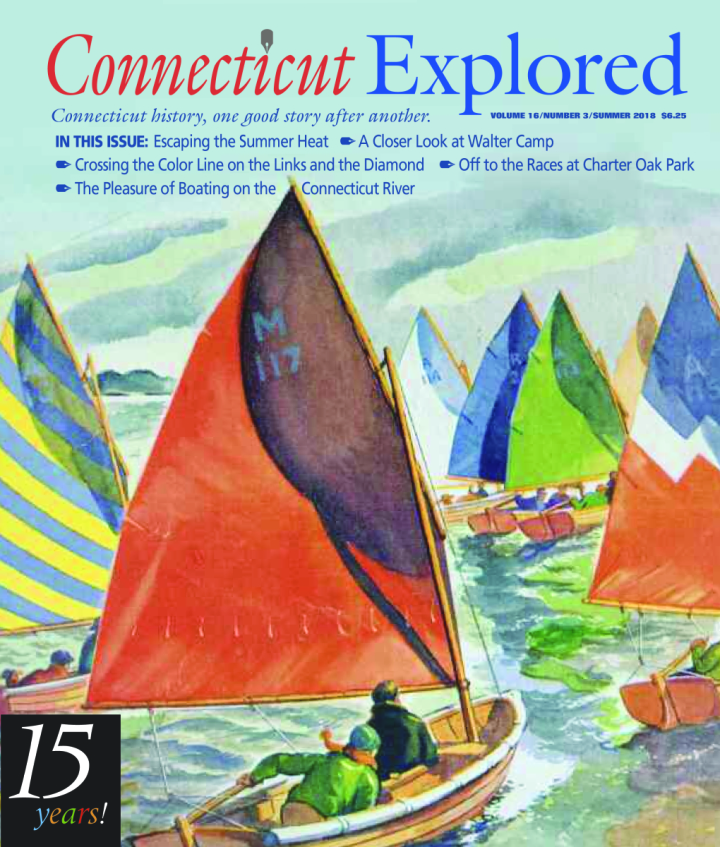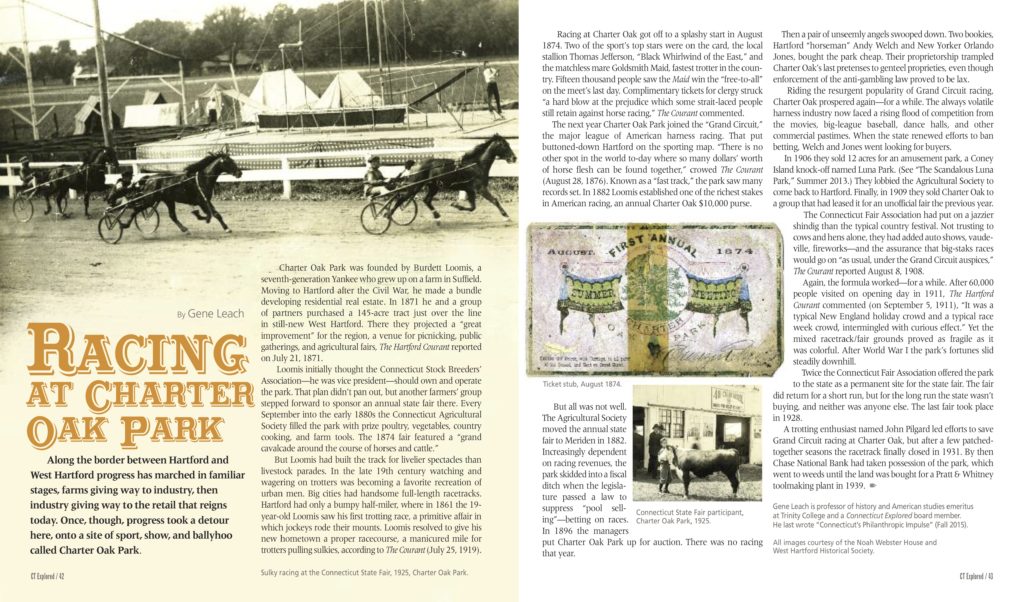By Gene Leach
(c) Connecticut Explored Inc. Summer 2018
Subscribe/Buy the Issue!
Along the border between Hartford and West Hartford progress has marched in familiar stages, farms giving way to industry, then industry giving way to the retail that reigns today. Once, though, progress took a detour here, onto a site of sport, show, and ballyhoo called Charter Oak Park.
Charter Oak Park was founded by Burdett Loomis, a seventh-generation Yankee who grew up on a farm in Suffield. Moving to Hartford after the Civil War, he made a bundle developing residential real estate. In 1871 he and a group of partners purchased a 145-acre tract just over the line in still-new West Hartford. There they projected a “great improvement” for the region, a venue for picnicking, public gatherings, and agricultural fairs, The Hartford Courant reported on July 21, 1871.
Loomis initially thought the Connecticut Stock Breeders’ Association—he was vice president—should own and operate the park. That plan didn’t pan out, but another farmers’ group stepped forward to sponsor an annual state fair there. Every September into the early 1880s the Connecticut Agricultural Society filled the park with prize poultry, vegetables, country cooking, and farm tools. The 1874 fair featured a “grand cavalcade around the course of horses and cattle.”
But Loomis had built the track for livelier spectacles than livestock parades. In the late 19th century watching and wagering on trotters was becoming a favorite recreation of urban men. Big cities had handsome full-length racetracks. Hartford had only a bumpy half-miler, where in 1861 the 19-year-old Loomis saw his first trotting race, a primitive affair in which jockeys rode their mounts. Loomis resolved to give his new hometown a proper racecourse, a manicured mile for trotters pulling sulkies, according to The Courant(July 25, 1919).
Racing at Charter Oak got off to a splashy start in August 1874. Two of the sport’s top stars were on the card, the local stallion Thomas Jefferson, “Black Whirlwind of the East,” and the matchless mare Goldsmith Maid, fastest trotter in the country. Fifteen thousand people saw the Maidwin the “free-to-all” on the meet’s last day. Complimentary tickets for clergy struck “a hard blow at the prejudice which some strait-laced people still retain against horse racing,” The Courantcommented.
 The next year Charter Oak Park joined the “Grand Circuit,” the major league of American harness racing. That put buttoned-down Hartford on the sporting map. “There is no other spot in the world to-day where so many dollars’ worth of horse flesh can be found together,” crowed TheCourant (August 28, 1876). Known as a “fast track,” the park saw many records set. In 1882 Loomis established one of the richest stakes in American racing, an annual Charter Oak $10,000 purse.
The next year Charter Oak Park joined the “Grand Circuit,” the major league of American harness racing. That put buttoned-down Hartford on the sporting map. “There is no other spot in the world to-day where so many dollars’ worth of horse flesh can be found together,” crowed TheCourant (August 28, 1876). Known as a “fast track,” the park saw many records set. In 1882 Loomis established one of the richest stakes in American racing, an annual Charter Oak $10,000 purse.
But all was not well. The Agricultural Society moved the annual state fair to Meriden in 1882. Increasingly dependent on racing revenues, the park skidded into a fiscal ditch when the legislature passed a law to suppress “pool selling”—betting on races. In 1896 the managers put Charter Oak Park up for auction. There was no racing that year.
Then a pair of unseemly angels swooped down. Two bookies, Hartford “horseman” Andy Welch and New Yorker Orlando Jones, bought the park cheap. Their proprietorship trampled Charter Oak’s last pretenses to genteel proprieties, even though enforcement of the anti-gambling law proved to be lax.
Riding the resurgent popularity of Grand Circuit racing, Charter Oak prospered again—for a while. The always volatile harness industry now faced a rising flood of competition from the movies, big-league baseball, dance halls, and other commercial pastimes. When the state renewed efforts to ban betting, Welch and Jones went looking for buyers.
In 1906 they sold 12 acres for an amusement park, a Coney Island knock-off named Luna Park. [See “The Scandalous Luna Park,” Summer 2013.] They lobbied the Agricultural Society to come back to Hartford. Finally, in 1909 they sold Charter Oak to a group that had leased it for an unofficial fair the previous year.
The Connecticut Fair Association had put on a jazzier shindig than the typical country festival. Not trusting to cows and hens alone, they had added auto shows, vaudeville, fireworks—and the assurance that big-stake races would go on “as usual, under the Grand Circuit auspices,” The Courantreported August 8, 1908.
Again, the formula worked—for a while. After 60,000 people visited on opening day in 1911, The Hartford Courantcommented (on September 5, 1911), “It was a typical New England holiday crowd and a typical race week crowd, intermingled with curious effect.” Yet the mixed racetrack/fair grounds proved as fragile as it was colorful. After World War I the park’s fortunes slid steadily downhill.
Twice the Connecticut Fair Association offered the park to the state as a permanent site for the state fair. The fair did return for a short run, but for the long run the state wasn’t buying, and neither was anyone else. The last fair took place in 1928.
A trotting enthusiast named John Pilgard led efforts to save Grand Circuit racing at Charter Oak, but after a few patched-together seasons the racetrack finally closed in 1931. By then Chase National Bank had taken possession of the park, which went to weeds until the land was bought for a Pratt & Whitney toolmaking plant in 1939.
Gene Leach is professor of history and American studies emeritus at Trinity College and a Connecticut Explored board member. He last wrote “Connecticut’s Philanthropic Impulse” (Fall 2015).

